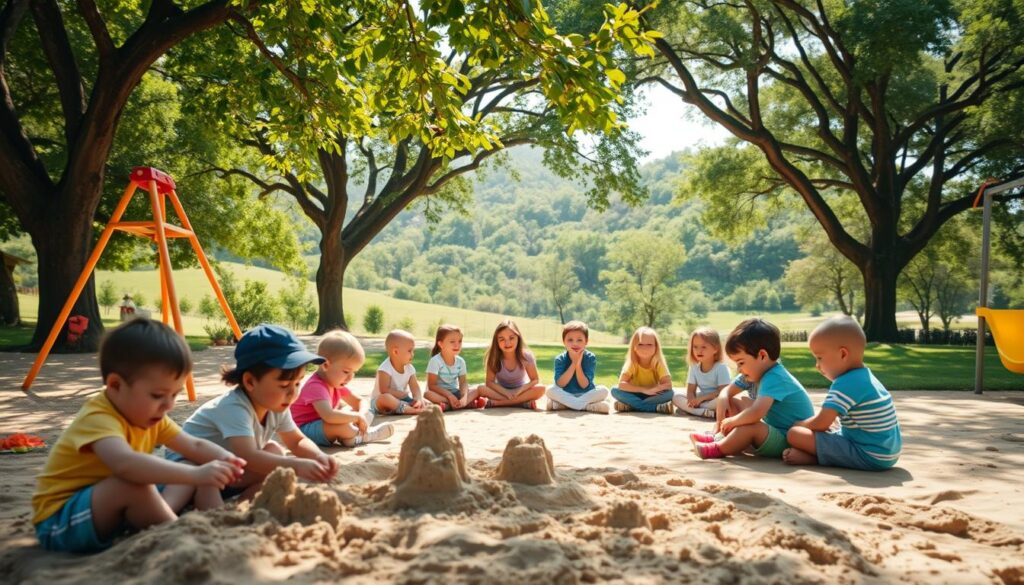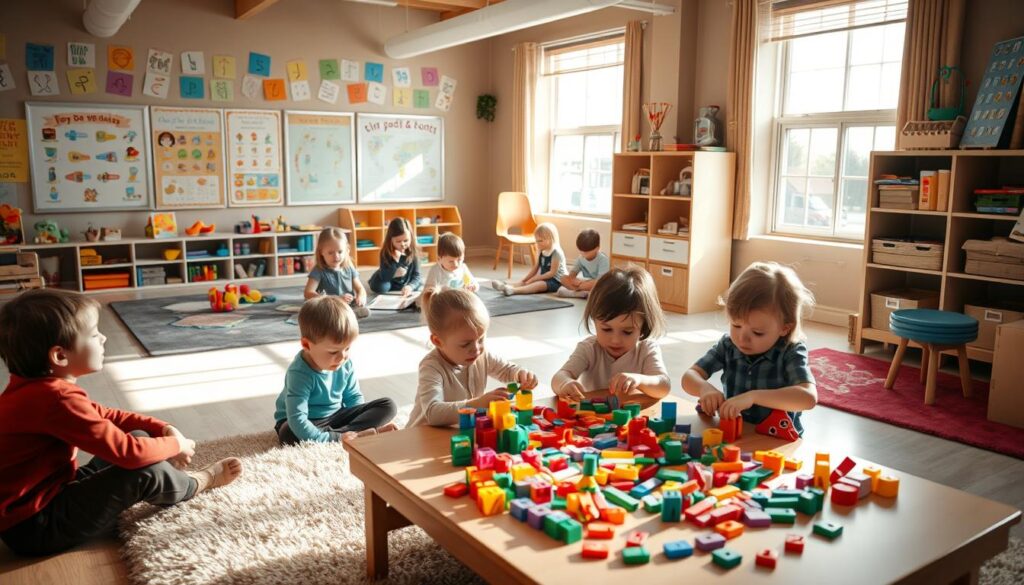As a parent or educator, have you ever wondered how children develop essential skills and build a strong foundation for lifelong learning?
The answer lies in the simple yet profound act of play. It’s through play that children explore their world, develop cognitive, social, emotional, and physical abilities, and lay the groundwork for future academic success.
Research has shown that playful learning experiences are crucial for developing stronger executive function skills, better social-emotional regulation, and more creative problem-solving abilities in children.
In this article, we’ll explore the significance of play in early development and provide insights into how parents and educators can harness its power to foster a love of learning that lasts a lifetime.
Understanding the Power of Play Early Learning
Play is not just a recreational activity; it’s a vital component of early learning that has a profound impact on child development. As we delve into the world of early learning, it’s essential to understand the significance of play and its role in shaping young minds.
What Defines Playful Learning
Playful learning describes a context where children actively engage with materials, ideas, and people in ways that are simultaneously joyful and mentally engaging. It’s not just about “having fun” but deeply processing information. In playful learning environments, children are not passive recipients of information; they’re actively constructing understanding through exploration, experimentation, and discovery.
The False Dichotomy Between Play and Learning
The persistent belief that learning must be rigid and teacher-directed—the opposite of play—is a misconception that has been challenged by research. Newer studies allow us to reframe the debate as learning via play—as playful learning. This approach recognizes that play and learning aren’t opposing forces but complementary processes that work together to optimize child development. Teachers who understand playful learning recognize that it’s not about choosing between academic content and play, but rather finding ways to teach important concepts through playful approaches.
The Developmental Benefits of Play
Play is a powerful tool that helps children develop in multiple ways, from social and emotional growth to cognitive and academic skills. Through play, children learn about themselves and the world around them, developing essential skills that will benefit them throughout their lives.
Social and Emotional Development
Play serves as a catalyst for social emotional development, helping children recognize and manage their feelings, develop empathy, and build meaningful relationships with peers. During play, children practice crucial emotional development skills like taking turns, resolving conflicts, and regulating their reactions to disappointment or frustration.
Cognitive Skills and Executive Function
The cognitive benefits of play are equally impressive, as children develop executive function skills including working memory, flexible thinking, and self-control through games that require planning, problem-solving, and adapting to changing situations. This helps children become more effective problem-solvers and thinkers.
Language and Literacy Development
Language and literacy flourish during play as children engage in rich conversations, expand their vocabulary, tell stories, and begin recognizing that symbols (like letters) carry meaning. This lays the foundation for future academic success.
Math and Science Foundations
Even math concepts develop naturally through play when children count toys, recognize patterns, sort objects, measure ingredients in pretend cooking, or build structures that require spatial reasoning. Science concepts emerge as children experiment with cause and effect, make predictions, test hypotheses, and observe natural phenomena.

| Domain | Skills Developed | Examples of Play |
|---|---|---|
| Social and Emotional | Self-regulation, empathy, relationships | Role-playing, sharing toys, resolving conflicts |
| Cognitive | Problem-solving, classification, executive function | Puzzles, strategy games, building structures |
| Language and Literacy | Vocabulary, communication, storytelling | Reading books, creating stories, engaging in conversations |
| Math and Science | Counting, sorting, spatial reasoning, experimentation | Counting toys, building with blocks, conducting simple experiments |
The Play Spectrum: Different Types of Play
The play spectrum offers a nuanced understanding of how children learn through different forms of play, from completely child-directed to more structured activities. This spectrum is crucial for educators and parents to recognize the diverse ways children engage in play, fostering their development and learning.
Free Play: Child-Directed Exploration
Free play is a type of play where children are given the freedom to choose what, how, and with whom they want to play without any adult direction or predetermined learning goals. During free play, children develop initiative, independence, creativity, and problem-solving skills as they explore materials and ideas based on their own interests and curiosity.
This type of play is essential for children as it allows them to take risks, make decisions, and learn from their mistakes in a safe and supportive environment. By engaging in free play, children can explore their creativity and develop a sense of agency over their learning experiences.
Guided Play: Balancing Structure and Freedom
Guided play strikes a balance between structure and freedom, where teachers or adults set up the environment or suggest a starting point, but children maintain the agency in directing how the play unfolds. In guided play, teachers can introduce materials or ask questions that guide children toward specific learning goals while preserving the playful nature of the experience.
This approach allows teachers to intentionally design learning experiences that match their instructional goals while maintaining the engagement and joy associated with playful learning. Research has shown that guided play is particularly effective for teaching academic content to young children.
Learning Through Games
Learning through games offers a more structured form of play where rules provide a framework. Despite the structure, children still experience joy, choice, and active engagement while practicing specific skills. Games can be designed to promote various aspects of learning, including social skills, problem-solving, and cognitive development.
By incorporating games into their learning activities, teachers can create engaging and interactive experiences that support the development of important skills in children. This approach to learning through play can make complex concepts more accessible and fun for young learners.
The Adult’s Role in Play-Based Learning
As we explore the world of play-based learning, it’s crucial to understand the pivotal role adults play in nurturing a child’s development. The best addition to your child’s play is you; your involvement can take their play to the next level. By observing their interests, asking thoughtful questions, and providing materials that match their developmental level, you can help support their growth.
Being the “Guide on the Side”
Being the “guide on the side” means positioning yourself as a facilitator rather than a director. This involves asking open-ended questions that extend thinking rather than seeking predetermined “right” answers. Effective teachers and educators recognize when to step back and observe, when to join in as a play partner, and when to gently scaffold learning by adding complexity or introducing new vocabulary. This approach enables children to explore and learn at their own pace.
Creating Environments That Encourage Play
Creating environments that encourage rich play involves a thoughtful selection of materials that are open-ended, culturally relevant, and matched to children’s developmental levels and interests. The physical arrangement of space significantly impacts play quality; well-organized, clearly defined areas with accessible materials invite deeper engagement and more complex play scenarios. A well-designed play environment can foster a child’s curiosity and creativity, making it an essential aspect of play-based learning.
Following Children’s Interests and Leads
Following children’s interests and leads means truly listening to their questions, observing what captivates them, and using these observations to extend learning in meaningful ways. When adults respect children’s play by giving it adequate time, space, and attention, they communicate that play is valued as important work rather than just a break from “real learning.” Research shows that children engage more deeply and learn more effectively when adults follow their lead rather than imposing their own ideas about how play should unfold.
| Adult’s Role | Description | Benefits |
|---|---|---|
| Being the “Guide on the Side” | Facilitating learning through open-ended questions and observations | Encourages independent thinking and exploration |
| Creating Play Environments | Designing spaces that are open-ended and relevant to children’s interests | Fosters curiosity, creativity, and deeper engagement |
| Following Children’s Leads | Observing and responding to children’s interests and questions | Enhances learning effectiveness and depth of engagement |
Integrating Play Into Everyday Learning
You don’t need a separate playtime to foster learning; everyday activities can be turned into engaging play-based experiences. By incorporating play into daily routines, you can create a rich learning environment that supports your child’s development across various domains.
Play-Based Approaches to Literacy
Play-based approaches to literacy make language come alive through storytelling, puppet shows, and dramatic play centers. When literacy materials are integrated into play scenarios, children practice reading and writing for authentic purposes. For example, menus in a restaurant play area or prescription pads in a doctor’s office encourage children to engage with text in meaningful ways.
Playful Math and Science Exploration
Math exploration happens naturally when children build with blocks (geometry), sort collections (classification), or measure ingredients in pretend cooking (measurement). Similarly, science exploration becomes accessible through water play (exploring properties of matter), ramps and balls (physics), and gardening (biology). These activities feel like play but build foundational skills in math and science.
Incorporating Play Into Daily Routines
Incorporating play into everyday activities transforms mundane moments into learning opportunities. For instance, setting the table becomes a counting exercise, and folding laundry becomes a lesson in matching and categorizing. By adding a playful element to daily tasks, you make the experience both joyful and educational. Allow extra time for your child to try things on their own, building motor skills, confidence, and independence.

Effective practice involves being intentional about the skills you want to develop while remaining flexible enough to follow children’s natural curiosity and interests. By adopting this mindset, you can turn everyday activities into valuable play learning experiences.
Breaking Common Misconceptions About Play
The true value of play is often overlooked in discussions about early learning. As a result, many people misunderstand the role of play in children’s development. In reality, play is a powerful learning tool that fosters cognitive, social, and emotional growth.
Play Is More Than Just Fun
One of the most persistent misconceptions about play is that it’s “just fun” without any real learning value. However, play is children’s most natural and effective way of developing crucial skills and understanding complex concepts. When adults dismiss play as merely recreational, they miss the profound development happening beneath the surface.
Academic Learning Through Play
Research consistently shows that academic learning through play is not only possible but often more effective than direct instruction for young children. Early childhood research demonstrates that children in play-based programs often outperform their peers in more academic settings on measures of reading, mathematics, and social-emotional development by elementary school.
The Balance Between Structure and Freedom
Finding the right balance between structure and freedom is key to effective play-based learning. Too much structure can kill the joy and agency that make play powerful, while too little structure may not sufficiently support learning goals. In high-quality early childhood programs, teachers skillfully weave learning goals into playful experiences, recognizing that play and learning are complementary rather than competing priorities.
By understanding the true value of play, we can better support children’s learning and development. This involves observing children during play, identifying what they’re learning, and creating environments that encourage playful exploration.
Best Practices for Educators and Parents
As we explore the world of play-based learning, it’s essential for educators and parents to understand the best practices that foster a nurturing environment for children. By working together, we can create a seamless learning experience that supports a child’s development across different settings.
Creating Play-Rich Environments
Creating play-rich environments begins with thoughtfully selected materials that are open-ended, allowing for multiple uses and supporting various developmental goals simultaneously. Effective teachers arrange classroom spaces to encourage different types of play—quiet areas for reading and puzzles, active spaces for building and movement, and social areas for dramatic play and collaboration.
Observing and Documenting Learning Through Play
Observing and documenting learning through play provides valuable assessment information while honoring the process of play itself. By taking photos, recording conversations, and collecting work samples, educators can make learning visible. When educators share documentation with children, it helps them reflect on their own learning and often inspires them to extend their play in new directions.
Building Partnerships Between Home and School
Building strong partnerships between home and school creates continuity in children’s play experiences and helps parents understand the value of what might look like “just playing” in the classroom. Effective communication about learning goals helps parents recognize and support the important skills their child is developing through play, both at school and at home.
Conclusion: Embracing the Power of Play for Lifelong Learning
Embracing the power of play is essential for fostering a love of learning that lasts a lifetime. As we’ve explored, play is not just a frivolous activity, but a powerful tool for developing essential skills in children. The benefits of play extend far beyond early childhood, laying the groundwork for creativity, critical thinking, collaboration, and communication—skills that are vital for success in both academic and professional pursuits.
Research has consistently shown that children who experience rich play opportunities in early childhood develop stronger executive function skills, which are better predictors of academic success than early academic instruction. By embracing play as a legitimate and powerful learning approach, we honor children’s natural development while preparing them for future challenges.
As parents and educators, it’s our responsibility to resist pressures to accelerate academic instruction at the expense of play, standing firm in what developmental science tells us about how young children learn best. By advocating for play-based approaches in early childhood settings, we can help children develop into confident, capable learners who approach challenges with curiosity, persistence, and joy.
The most powerful gift we can give children is not early academic instruction, but the opportunity to develop through play. By doing so, we’re not just preparing them for school; we’re preparing them for life, fostering resilience, problem-solving, creativity, and the ability to collaborate with others.
FAQ
What is the role of play in a child’s social and emotional development?
Play helps children develop essential social and emotional skills, such as cooperation, empathy, and self-regulation. Through play, children learn to navigate relationships, manage their emotions, and develop a sense of self-awareness.
How can I create a play-rich environment for my child?
To create a play-rich environment, provide your child with a variety of materials and opportunities for exploration, such as blocks, puzzles, and art supplies. Ensure the space is safe and allows for freedom of movement and creativity.
What is the difference between free play and guided play?
Free play is child-directed, allowing children to explore and learn at their own pace. Guided play, on the other hand, involves adults providing gentle guidance and support to help children achieve specific learning goals.
How can I incorporate play into my child’s daily routine?
You can incorporate play into daily routines by turning everyday activities into playful experiences, such as singing songs during bath time or using play-based approaches to teach literacy and math skills.
Is play-based learning effective for developing academic skills?
Yes, play-based learning is effective for developing academic skills, such as literacy, math, and science. Play helps children develop a deep understanding of concepts and builds a strong foundation for future academic success.
How can educators and parents work together to support play-based learning?
Educators and parents can work together by sharing observations, setting common goals, and creating a cohesive approach to play-based learning. This partnership helps ensure consistency and reinforces the value of play in a child’s educational journey.




